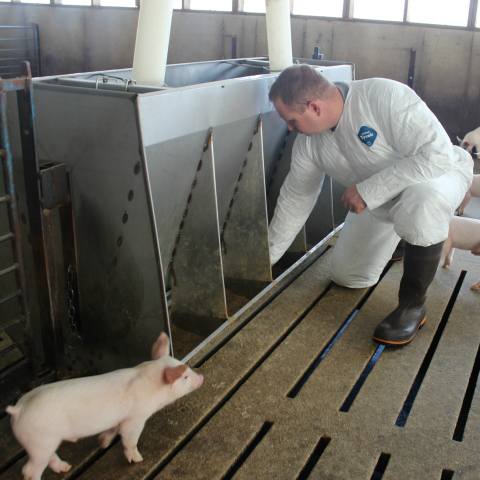
How to Avoid Heat Stress in Pigs to Support Summer Performance in Your Grow/Finish Barn
Grow/Finish : Grow Finish Production

Heat stress in pigs is the result of the animals’ need to spend excessive energy to manage its body temperature during hot and humid conditions.
Heat stress negatively impacts feed intake and feed conversion, which in turn negatively impacts your bottom line.
The best time to minimize the impact of heat stress is before your pigs feel it. Here are recommendations to keep your grow/finish pigs as comfortable as possible during summer months to support optimal performance.
Want more ideas to support optimal performance in your grow/finish barns? Contact your local Purina® sales representative, or visit progresstoprofit.com.
1 Nicholas et al., 1983
Heat stress negatively impacts feed intake and feed conversion, which in turn negatively impacts your bottom line.
The best time to minimize the impact of heat stress is before your pigs feel it. Here are recommendations to keep your grow/finish pigs as comfortable as possible during summer months to support optimal performance.

Want more ideas to support optimal performance in your grow/finish barns? Contact your local Purina® sales representative, or visit progresstoprofit.com.
Pig barn environment
The goal of pig barn ventilation is to move as much air as possible without creating a draft or causing stress to the pigs.- The optimal temperature for pigs entering the nursery in summer is 82 degrees. By the time those pigs reach 70 days post-weaning, the optimal temperature is 64 degrees.
- Lower your set point to 62 degrees by the time a group reaches 100 pounds. Remember your set point is not the temperature you want in your barn; it’s the temperature at which you want your controller to operate.
- Ideal humidity is between 60 and 70 percent.
- If your controller stage differential is usually set at 2 degrees, set it to 1.5 degrees in the summer.
Adjust your sprinklers
Research has shown using on/off sprinklers can support better grow/finish pig performance than continuous fogger1 because evaporation is what cools your pigs – not the wetting action.- Set your sprinklers at 18-20 degrees above your set point once the barn reaches about 100 pounds average body weight.
- Set your “on” time for two minutes, which should be enough time to wet down 60 percent of the pen.
- Set your “off” time at 20 minutes in summer, and turn it down to 15 minutes on the warmest days.
Use space wisely
Your biggest pigs are creating the most body heat in the barn. A few changes can help you manage the heat and keep your pigs comfortable and eating.- Plan for a minimum of 7 square feet per pig for summer finishing groups.
- Considering scheduling your first cut of a summertime sale a week sooner than you would in other seasons to reduce competition at the feeder and reduce heat production in that barn, giving the remaining pigs a chance to put on optimal finishing weight.
Minimize pig feed outages
Outages are common in summer because increased humidity can cause feed to bridge in bins and feeders. A good practice is to check your barns twice per day to minimize the chance of a 24-hour feed outage.- In your daily walk-through, check feeders and augers for bridging, and confirm you have 50 percent pan coverage for optimal intake.
- Check your waterers. Pigs will drink 1 gallon of water per 100 pounds of bodyweight per day when they are comfortable. In hot weather, that can increase by as much as 50 to 70 percent per day.
- Record feed intakes, water intakes, temperatures and fan operation, and combine this data with what you observed about your pigs’ behavior.
- In the heat of summer, pigs are more likely to eat at night. If you check your feeders a second time in the evening, you increase the likelihood your pigs will have feed overnight when they’re hungry.
Take care when trucking
When you sell pigs, load your trucks early and take your time. Move fewer pigs at a time to minimize stress for people and pigs.- Consider reducing load sizes by 5 percent in summer to minimize mortality or down pigs.
- Have a hose ready for the driver to wet pigs before leaving.
- Ask your trucker to keep track of times at the processing facility, including how long the truck is in line to unload and how long it takes to unload the truck. Work with your processor if the times are longer than you think safe for your pigs.
1 Nicholas et al., 1983



